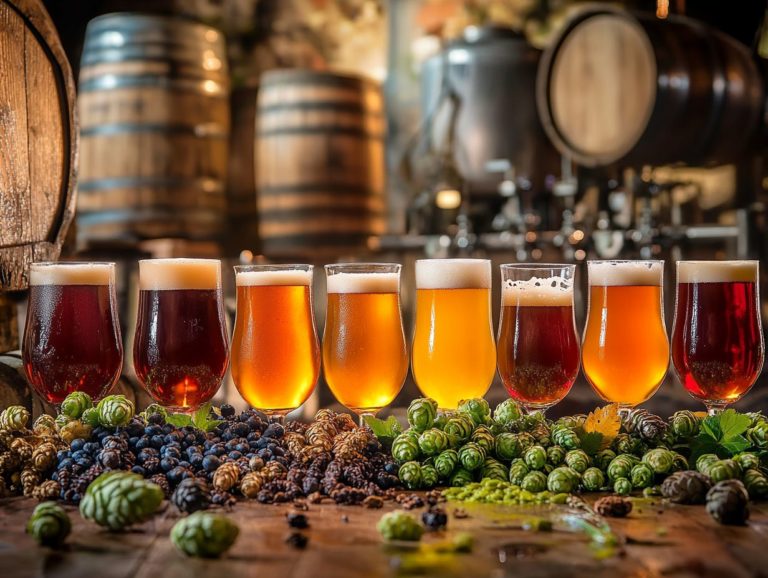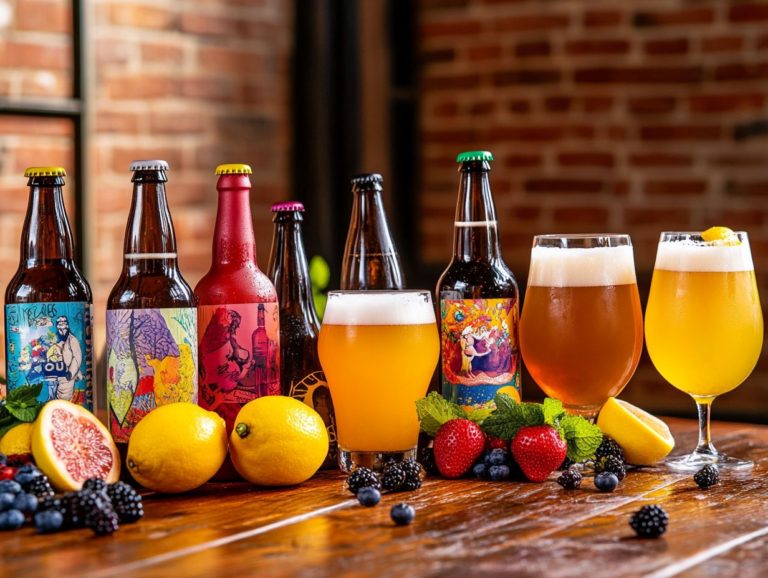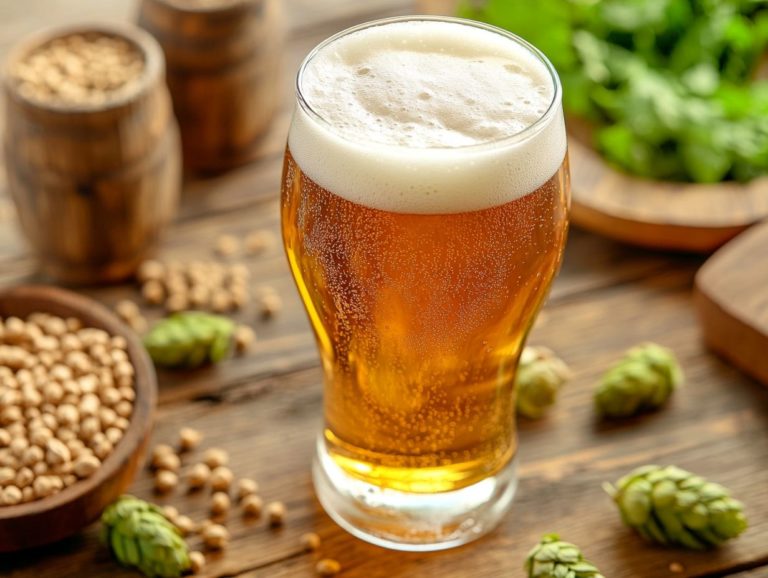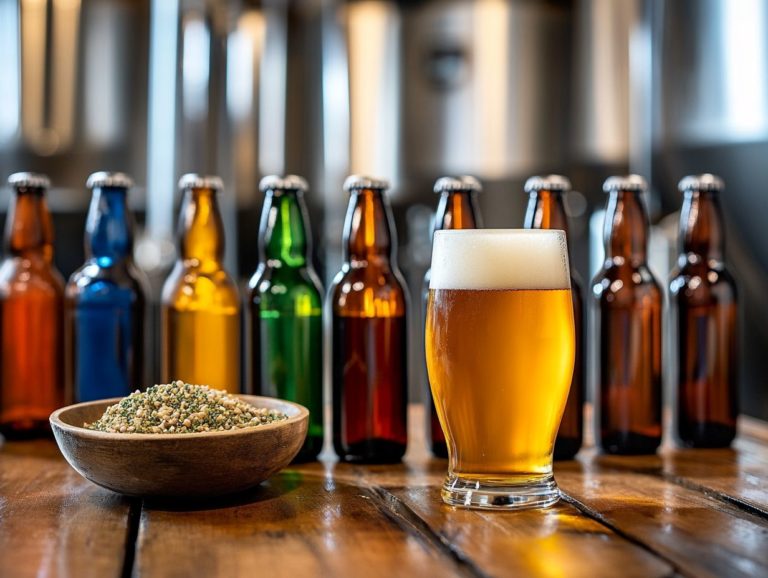Exploring the Unique Qualities of Light Ales
Light ales have certainly earned a cherished spot among beer enthusiasts, celebrated for their crisp, refreshing character and versatile flavor profiles. These brews boast unique ingredients and brewing techniques that truly distinguish them, offering a delightful array of sub-styles from blonde to K lsch, and even tropical ales.
With perfect food pairings at your fingertips, you’ll appreciate the health benefits lighter ales offer. Expert tips on serving them can elevate your drinking experience.
Immerse yourself in the world of light ales and discover why they make an exceptional choice for any occasion, especially when exploring various beer styles!
Contents
- Key Takeaways:
- What Makes Light Ales Unique?
- Flavor Profile of Light Ales
- Different Types of Light Ales
- Blonde Ales
- Golden Ales
- K lsch Ales
- Pale Ales
- Food Pairings with Light Ales
- Health Benefits of Light Ales
- May Improve Heart Health
- How to Serve and Enjoy Light Ales
- Frequently Asked Questions
- Food Pairing with Light Ales
Key Takeaways:
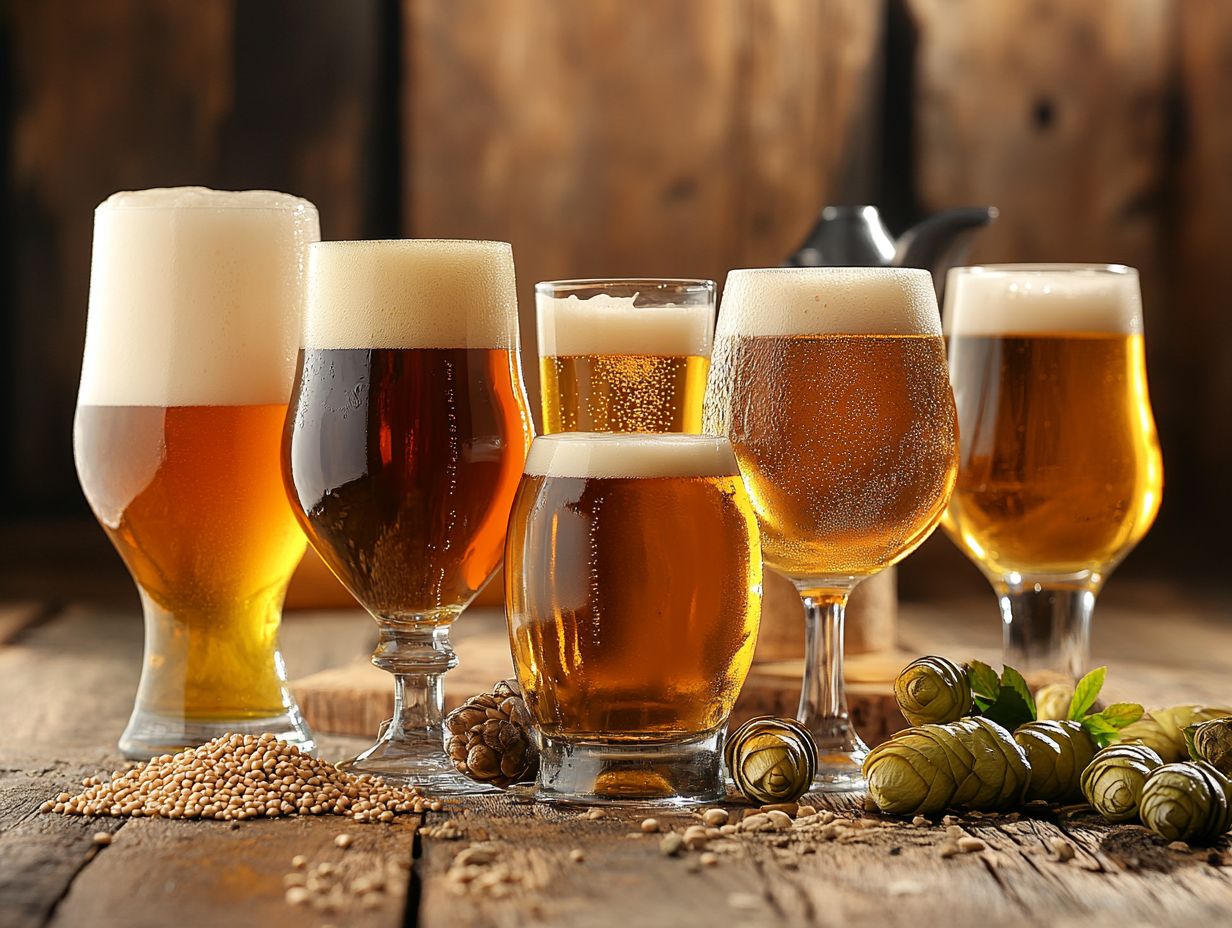
- Light Ales stand out from other beer styles due to specific ingredients, brewing processes, and flavor profiles.
- Types of light ales include blonde, golden, K lsch, and pale ales, each with unique characteristics.
- Enjoy light ales with various foods. They offer health benefits like lower calorie content and antioxidants, enhancing beer culture.
What Makes Light Ales Unique?
Light ales represent a captivating category within brewing. They attract beer enthusiasts with crisp finishes, refreshing flavors, and lower alcohol content.
Typically crafted with lighter malts and specific yeast strains, these ales boast subtle yet intriguing flavors. This distinguishes them from traditional, heavier beers like stouts and porters.
Key Ingredients That Define Light Ales
The ingredients in light ales include a thoughtful blend of lighter malts, specific yeast strains, and carefully chosen hops. These elements are essential in shaping the beer’s distinctive flavor.
Lighter malts like Pilsner or pale malt create a delicate sweetness and crisp mouthfeel. This forms a perfect canvas for the aromatic qualities of hops.
Hops such as Saaz or Cascade bring floral, citrusy, or herbal notes, enhancing the beer’s refreshing character. The yeast selection influences both aroma and clarity, leading to unique flavors.
The Art of Brewing Light Ales
The brewing process for light ales requires meticulous attention to detail. Specific techniques, fermentation characteristics, and precise temperature controls create the desired flavor and aroma.
It starts with the mashing phase, where you steep the grains in hot water to convert starches into fermentable sugars. This lays the foundation for the ale’s profile.
Next comes the vigorous boiling stage, where hops are added for bitterness and aroma. This layering adds complexity to the flavor.
After boiling, rapidly cool the wort to prepare for fermentation. Each brewery has a unique touch, using different yeast strains and fermentation temperatures that can alter the final character of the ale.
Such careful orchestration ensures a crisp finish and enhances vibrant aromas that craft beer enthusiasts savor.
Flavor Profile of Light Ales
Light ales are a true delight, bringing a refreshing balance that every beer lover will enjoy! They typically offer a harmonious balance between malt sweetness and hop bitterness, creating a refreshing experience for you, the beer enthusiast.
Take wheat ales, for instance. They often present a light, bready malt character paired with delightful hints of citrus and spice from the yeast, making them exceptionally thirst-quenching. In contrast, pale ales step it up with a more pronounced hop profile, where floral and fruity notes take center stage, often accompanied by a subtle caramel sweetness from the malts.
This meticulous interplay between the ingredients elevates the aroma and engages your palate, ensuring that each sip reveals a nuanced array of flavors. Ultimately, what distinguishes light ales is this masterful balancing act, allowing you to relish their refreshing qualities without being overpowered by bitterness.
Different Types of Light Ales
You ll discover a remarkable variety of light ales, each presenting its unique flavor profiles and characteristics tailored to satisfy a multitude of palates.
Among the most popular styles are blonde ales, golden ales, K lsch, and pale ales. Each invites you to explore their unique tastes and nuances.
Blonde Ales
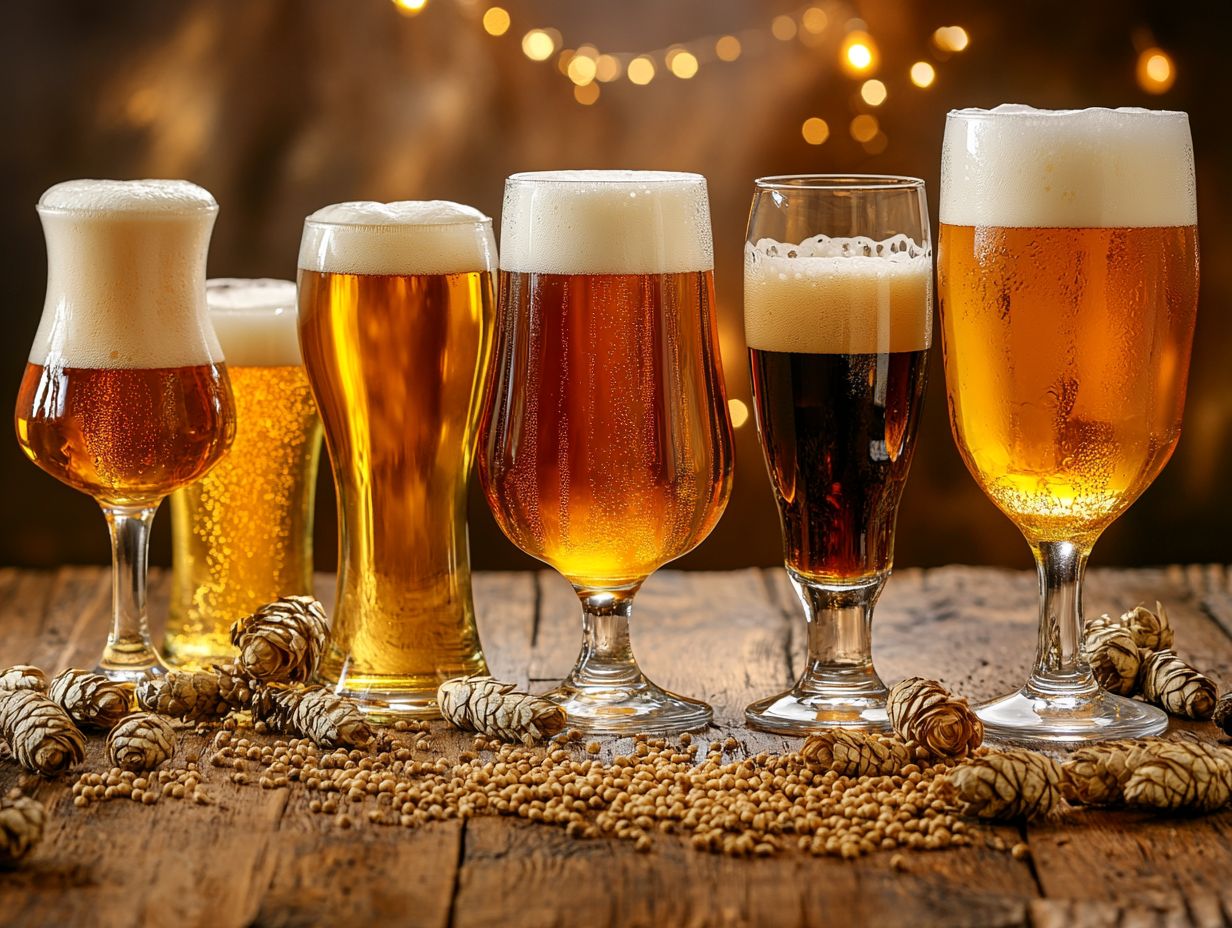
Blonde ales are a beloved sub-style of light ales, known for their golden hue, smooth texture, and refreshing qualities, making them ideal for those warm summer months.
These beers showcase a balanced malt profile that leans toward a subtle sweetness, often accompanied by delightful hints of biscuit or bread-like flavors. The hop bitterness is generally mild, allowing for a harmonious interplay between malts and hops, which makes these ales exceptionally drinkable.
Craft breweries often experiment with this style, introducing unique variations that may include fruity, floral, or even citrusy notes, all of which elevate the traditional blonde ale experience.
Versatile by nature, blonde ales pair beautifully with a variety of foods, such as grilled chicken, seafood, and light salads, enhancing your overall dining experience.
Golden Ales
Golden ales captivate with their radiant golden hue and lively aromas, offering a refreshing experience that resonates with many beer enthusiasts.
These ales showcase various brewing techniques that highlight the use of pale malts, lending themselves to a crisp, clean taste. Brewers often choose floral or citrusy hops to enhance the flavor, elevating the aromatic profile to new heights.
This thoughtful combination of ingredients strikes a harmonious balance between sweetness and bitterness, distinguishing them from other light ales. While some may lean more malt-forward, golden ales often present a lighter body and a refreshing finish, making them perfect for warm weather or casual gatherings.
K lsch Ales
K lsch ales represent a remarkable German beer style that beautifully blends the best of ale and lager characteristics. They offer a crisp finish and vibrant aromas that are hard to resist.
Hailing from the city of Cologne, these pale golden brews feature a thoughtful combination of pale malts and select German hops. This results in a light body complemented by a subtle bitterness.
The brewing process employs an intriguing fermentation method, utilizing yeast that ferments on top of the brew at lower temperatures. This contributes to the clean and refreshing profile that defines K lsch.
You ll often find these ales enjoyed fresh, served in their iconic cylindrical glass known as a ‘Stange’. They are ideal for casual sipping or pairing with lighter meals. With their delicate balance and exceptional drinkability, K lsch ales carve out a unique niche within the realm of light ales, appealing to both beer aficionados and casual drinkers alike.
Don t miss out on trying these refreshing ales!
Pale Ales
Pale ales are a beloved style of light ales, celebrated for their moderate hop bitterness and delightful floral aroma notes. These characteristics create a truly flavorful experience for the discerning palate. Among these, India pale ales (IPAs) stand out with their intense flavors and higher bitterness levels.
Pale ales date back to the 18th century in England. This style boasts a rich history that mirrors the evolution of brewing techniques through the ages.
Traditionally crafted with pale malts, pale ales exude a golden hue and a crisp finish. An array of hop varieties offers a fine balance of bitterness and aromatic qualities.
In recent years, craft breweries have wholeheartedly embraced this classic style. They infuse it with local and unique ingredients to produce an impressive spectrum of flavor profiles.
From fruity and citrusy interpretations to those showcasing earthy and resinous notes, the creative variations of pale ales highlight their ability to satisfy a wide range of tastes and preferences.
Food Pairings with Light Ales
Light ales present a great variety of food pairing opportunities that elevate your entire dining experience. By complementing a variety of dishes with their distinct flavor profiles, these brews enhance every bite, creating a great balance that delights the palate.
Whether you choose amber ales with grilled meats or golden ales with seafood, the pairing possibilities are endless.
Health Benefits of Light Ales
Beyond their enjoyable taste, light ales may offer several health benefits. Their lower calorie and carb content make them a better choice for those watching their intake. The antioxidants present in some varieties can contribute positively to overall health.
Light ales, such as wheat ales and pale ales, often contain ingredients that promote heart health, adding a wholesome aspect to your drinking experience.
With their lower calorie content, rich antioxidant properties, and potential to enhance heart health, indulging in a light ale can be a delightful and mindful choice for those looking to enjoy their beverages without compromising their well-being. These characteristics have made them a favorite among beer enthusiasts.
Lower Calorie and Carb Content
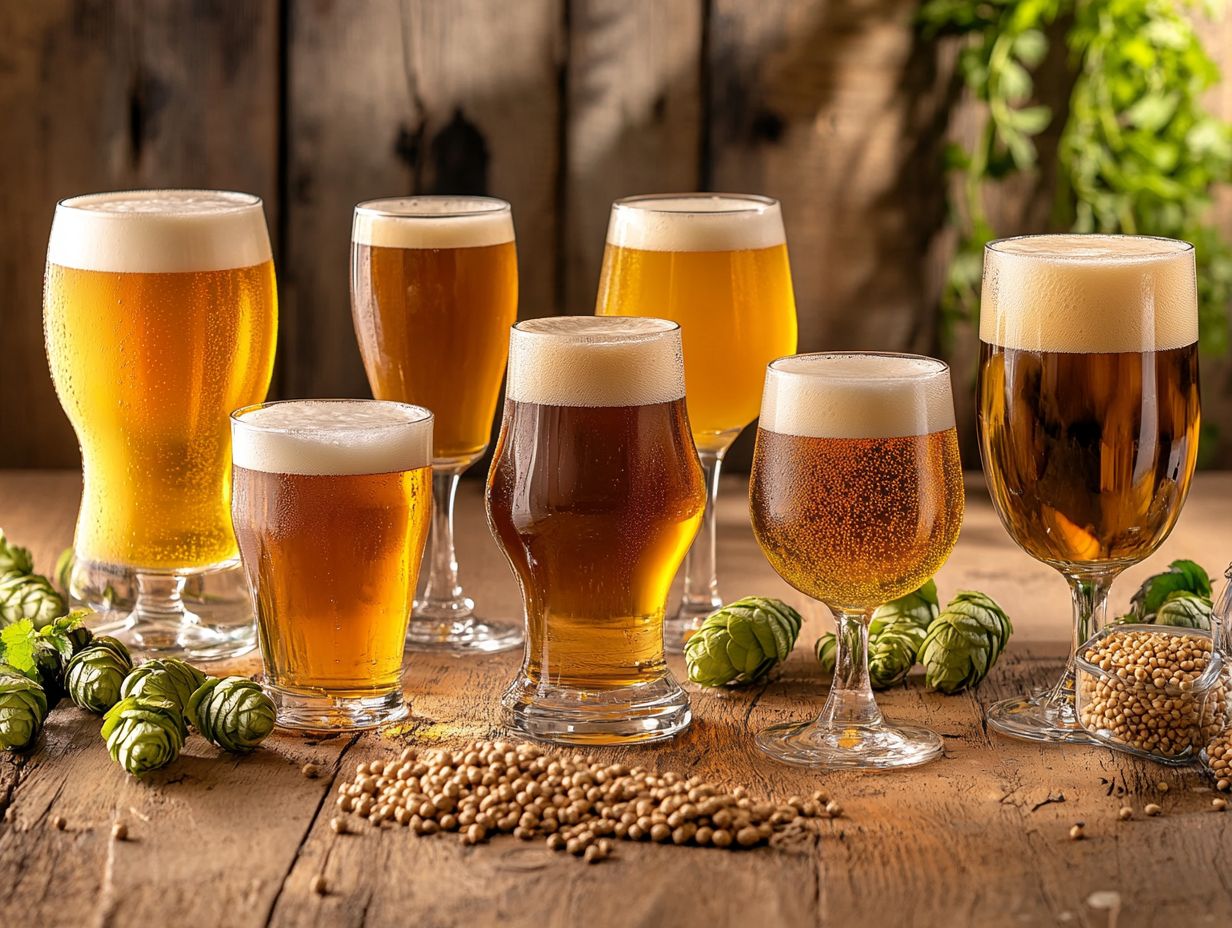
One of the most significant advantages of light ales is their lower calorie and carbohydrate content compared to traditional beer styles. This makes them a more health-conscious choice for discerning beer drinkers, especially when compared to beers like stout ales and porter ales.
Crafted through a meticulous brewing process, light ales often utilize specific types of malt and hops to create a refreshing flavor profile while keeping calorie counts manageable. Brewers adjust the way beer is made to keep it light and tasty.
With the rising awareness of health and wellness, light ales offer a guilt-free choice that invites you to enjoy your favorite beverages without worry! This makes them particularly popular during the summer months.
Rich in Antioxidants
Light ales are a treasure trove of antioxidants, helping to reduce oxidative stress and inflammation in your body. This ultimately contributes to your overall health and well-being. This is due, in part, to their unique characteristics and the brewing process.
Hops play a pivotal role as key sources of these beneficial compounds, delivering significant antioxidant properties while bringing unique flavors to your palate. Ingredients like barley and various fruits used in brewing also contribute to the impressive antioxidant content found in light ales. When consumed in moderation, these refreshing beverages may unlock health benefits, such as improved heart health and enhanced immune function, thanks to their ability to combat free radicals. Brewers love these qualities in light ales.
The natural fermentation process boosts the absorption of these antioxidants, making them more accessible to your body and promoting a healthier lifestyle.
May Improve Heart Health
Moderate consumption of light ales can be linked to potential improvements in heart health, thanks to their thoughtfully selected ingredients. This is one of the significant advantages these beer styles offer.
Research has shown that the polyphenols found in these beverages, natural compounds with antioxidant properties, along with their capacity to enhance blood circulation, may help reduce the risk of cardiovascular issues. Indulging in an occasional light ale can assist in maintaining healthy cholesterol levels while promoting overall heart wellness, especially when incorporated into a balanced lifestyle.
To truly harness these heart-healthy benefits, moderation is essential. This typically means keeping your intake to one or two servings a day. This strategy allows you to savor flavorful ales while aligning beautifully with health and well-being guidelines. Light ales fit perfectly into this framework.
How to Serve and Enjoy Light Ales
To truly appreciate the distinct characteristics of light ales, it is vital to serve and savor them in the right way. Pay attention to the recommended serving temperatures and choose the appropriate glassware to enhance your experience. This will help you enjoy the flavor profiles and aroma notes fully.
Recommended Serving Temperature
For the ultimate drinking experience, serve light ales chilled, ideally at temperatures between 38 F and 45 F. This range enhances their refreshing qualities, particularly for summer ales and tropical ales.
Serving these beers too cold can mask their subtle flavors and aromas, making it challenging to appreciate the craftsmanship that goes into each brew. Conversely, if they warm above 45 F, the delicate notes of hops and malt can become overly pronounced, disrupting the exquisite balance that light ales are celebrated for. This balance sets them apart from other traditional styles of ales.
To find that perfect temperature, chill your beers properly in a refrigerator or an ice bath, allowing them to gradually reach that sweet spot. Pouring them into a clean, appropriately sized glass elevates the experience further, enabling the aromas to fully develop and be savored.
Discover the delightful world of light ales and explore their unique flavor profiles today!
Glassware for Light Ales
The choice of glassware plays a crucial role in elevating your drinking experience when enjoying light ales, with certain designs expertly highlighting the beer s aromas and flavors. This is an aspect that many beer enthusiasts pay close attention to.
For instance, a slender pilsner glass is perfect for showcasing the golden hue and effervescence of light ales. Its elegant shape encourages the release of delicate hop aromas, thanks to its narrow opening. Alternatively, a tulip glass offers a deeper belly, allowing for a more concentrated aroma that transforms every sip into a fragrant delight. Different beer styles like cream ale or blonde ale can also benefit from the right glassware.
It’s also wise to consider using chilled glassware when serving, as it helps maintain the beer’s refreshing qualities. Pairing these glass styles with the right garnishes, such as a slice of citrus or fresh herbs, can further enhance the overall experience, tantalizing both your eyes and palate. This attention to detail is a hallmark of the craft breweries that produce these fine ales.
Best Occasions to Enjoy Light Ales
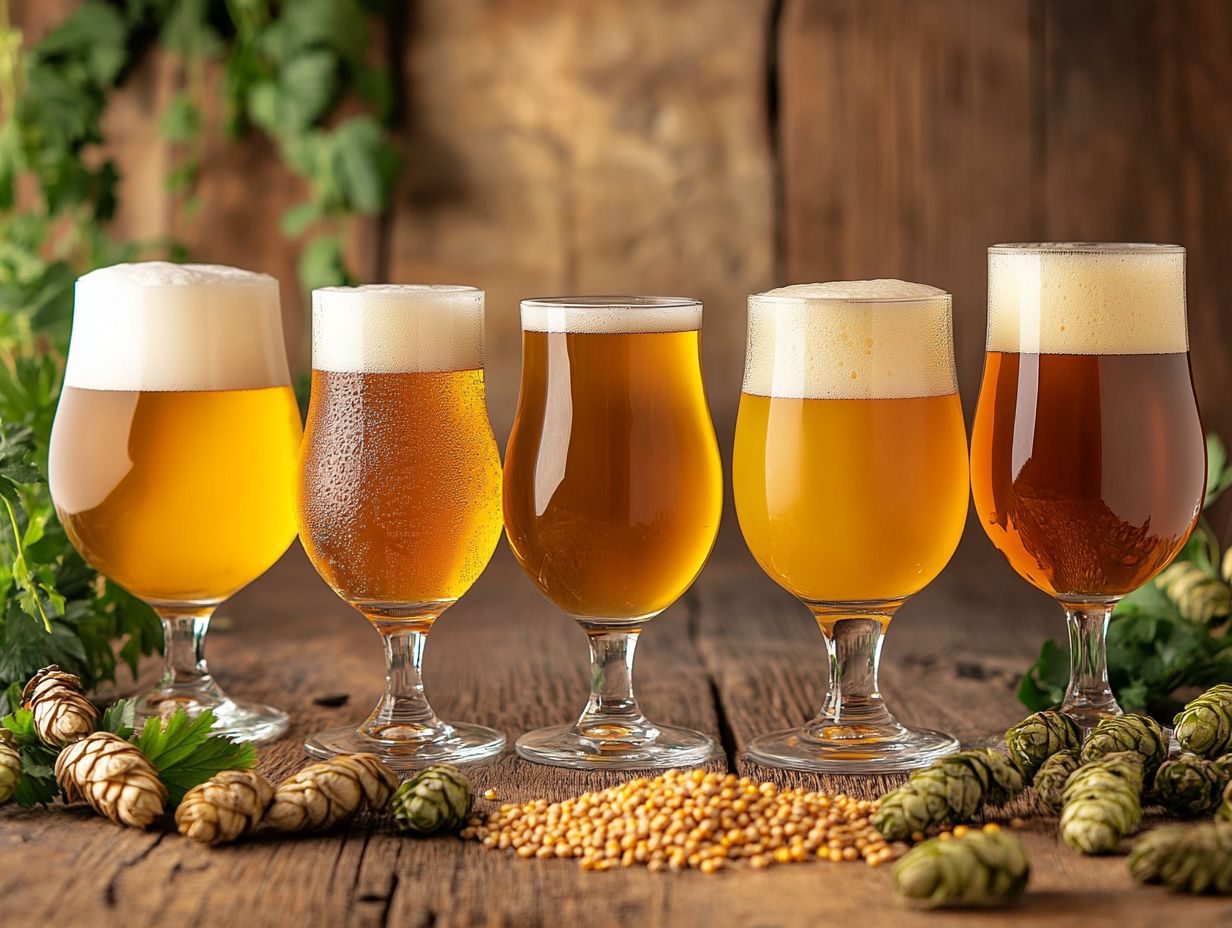
Light ales are the perfect beverage choice for an array of occasions, whether you re hosting a casual gathering or firing up the grill for a summer barbecue. Their refreshing flavors effortlessly enhance the social experience. They are also a popular choice during sun-drenched afternoons.
These versatile brews strike an exceptional balance between taste and drinkability, making them particularly enticing for outdoor picnics or rooftop happy hours. At art festivals, their light-bodied nature not only complements the vibrant atmosphere but also pairs wonderfully with the diverse culinary offerings from various food vendors. Craft breweries have certainly caught on to this trend, often curating seasonal light ales specifically tailored for such events, ensuring you have the ideal drink to enjoy during sun-drenched afternoons. This is a testament to the diversity of choices within the brewing world.
As you plan a delightful summer evening, consider serving a citrus-infused light ale alongside grilled seafood; the zesty notes will harmonize beautifully. And if you re gearing up for a game-day viewing party, light ales make an excellent companion to spicy wings or nachos, delighting your taste buds without overwhelming them. This flexibility in food pairing options makes light ales a favorite among many.
Frequently Asked Questions
What are light ales?
Light ales are a type of beer that has a lighter color and body compared to other ales. They are generally lower in alcohol content and have a more subtle flavor profile. Unlike more robust styles like India pale ales or bitter ales, light ales offer a more delicate drinking experience.
How are light ales different from other ales?
Light ales are distinguished by their lighter color and body, lower alcohol content, and more subtle flavors compared to other ales such as pale ales, India pale ales, and brown ales. This makes them an excellent choice for those who prefer a milder, more refreshing experience.
What are the unique qualities of light ales?
Light ales have a crisp and refreshing taste, making them perfect for warm weather or as a session beer. They also have a lower calorie count and are often described as being “easy-drinking.” This makes them ideal for those who enjoy a session strength beer.
What types of light ales are available?
There are several types of light ales, including blonde ales, cream ales, K lsch, and Belgian witbier. Each type has its own unique qualities and flavor profiles. Other options include amber ales and red ales, which offer slightly different taste experiences.
Do light ales have lower alcohol content?
Yes, light ales typically have a lower alcohol content ranging from 3-5% ABV. This makes them a great option for those who prefer to have a few drinks without getting too intoxicated. Their fermentation characteristics are designed to keep the alcohol content low while still delivering excellent flavor.
Food Pairing with Light Ales
Are Light Ales Suitable for Food Pairing?
Absolutely! Light ales pair well with a variety of foods. Try them with salads, seafood, chicken, and lighter pasta dishes.
They also complement spicy and tangy flavors. This versatility makes them a fantastic choice for food pairing. Explore different light ales today and discover your favorite food pairings!


